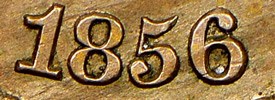Counterfeit Detection: Altered 1856 Flying Eagle Cent
Posted on 1/10/2017
By 1856 the half cent and large cent denominations had become extremely unpopular. They hardly circulated since their large sizes were simply too cumbersome to be useful in commerce. In addition, their size and 100% copper composition made them expensive to produce and the US Mint barely covered its costs when striking the coins. It was clearly time for a change.
With large cents still being issued, Chief Engraver James B. Longacre created dies for a smaller cent with a flying eagle design in 1856. A total of some 2,000-3,000 pieces of this prototype—or “pattern” in numismatic terminology—were struck. Examples were given to legislators and the public was also able to buy pieces directly from the Mint.
Due to the extremely low mintage of the 1856 Flying Eagle Cent, as well as the interesting tale behind its creation, examples are highly sought-after today. Of course, where there is high demand and high prices, counterfeiters enter the market.
The most commonly seen counterfeit 1856 Flying Eagle Cents are actually altered date 1856 Flying Eagle Cents. The coin pictured is one such example that was submitted to NGC.
 |
 |
| Altered Date 1856 Flying Eagle Cent Click images to enlarge. |
|
At first glance, one might not notice anything wrong with regards to the authenticity of this piece. The surfaces appear a little unnatural due to cleaning, but that certainly does not mean that the coin is fake. The coin has the correct “large letters” in the motto on the obverse, as you would expect to see on a genuine 1856 Flying Eagle Cent.
The 6 in the date, however, looks slightly too small compared to the other digits of the date. That is because this 6 was actually carved from an 8.
 |
|
|
Altered Date of 1856 Flying Eagle Cent Click images to enlarge. |
|
The alteration is much more obvious in the close-up above. Notice the unnatural horizontal striations around the 6. Those are tool marks left behind by the counterfeiter as they carefully sculpted a new digit. This simple alteration made a coin worth less than $100 appear to be a rarity worth perhaps $10,000.
 |
|
|
Genuine 1856 date on Flying Eagle Cent Click images to enlarge. |
|
There are other variances that differentiate this piece from genuine 1856 Flying Eagle cents as well. Compare the date on a genuine piece (above) with the date on the altered piece. As you can see, the shape of the “5” on the fake is not correct, which is most noticeable at the top and bottom. The genuine example also has a much bigger opening in the 6, which itself is much larger.
This is a common alteration that can lead to a very costly mistake for a buyer. It is important to carefully examine every coin, especially a key date such as the 1856 Flying Eagle Cent. If there is ever any doubt, buy coins certified by NGC, which are guaranteed to be genuine, from NGC Authorized Dealers.
Interested in more Counterfeit Detection articles, click here.
Stay Informed
Want news like this delivered to your inbox once a month? Subscribe to the free NGC eNewsletter today!